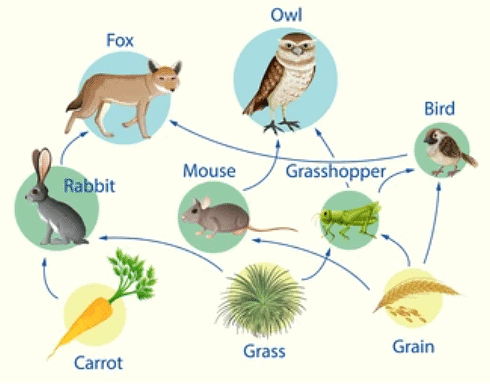Year 3 Exam > Year 3 Notes > Year 3 Science > Animals and food
Animals and food | Year 3 Science PDF Download
| Table of contents |

|
| Introduction |

|
| Three groups of animals |

|
| Diversity in Animal Teeth |

|
| Understanding Food Chains |

|
Introduction
- Plants have the remarkable ability to create their own food through photosynthesis, a process where sunlight is converted into energy.
- Unlike plants, animals cannot produce their own food and depend on consuming other organisms for sustenance. This holds true for humans as well.
Animals in Your Garden
- Animals and plants exist in various habitats, including the backyards of many homes.
- This segment delves into the types of food consumed by animals in these spaces.
Three groups of animals
Animals can be categorized into three main groups based on their diet:
- Herbivores: Herbivores like zebras and cows consume only plants for their nutrition.
- Carnivores: Animals such as lions and eagles primarily feed on other animals.
- Omnivores: Omnivores like bears and rats have a diet that includes both plants and other animals.
Diversity in Animal Teeth
Animals possess a variety of teeth structures that are adapted to their specific diets.
- Incisors: Used for cutting and biting. For instance, herbivores often have sharp incisors for tearing plants.
- Canines: Designed for tearing flesh. Carnivores typically have prominent canines for hunting and eating meat.
- Molars: Used for grinding and crushing food. Omnivores have molars that help them chew both plant matter and meat effectively.
- Specialized Teeth: Some animals, like rodents, have teeth that never stop growing, enabling them to continuously chew on tough materials.
Question for Animals and foodTry yourself: Which type of animal primarily feeds on other animals?View Solution
Understanding Food Chains
- Food chains are illustrations of what each living organism consumes. They encompass herbivores, omnivores, and carnivores.
- At the core of ecosystems, food chains define the flow of energy.

Importance of Food Chains
- Food chains demonstrate the interdependence of organisms in an ecosystem.
- Each link in a food chain is vital for maintaining balance and sustainability.
Key Concepts in Food Chains
- Herbivores feed on plants, while carnivores prey on other animals.
- Omnivores consume both plant and animal matter, showcasing adaptability and varied diets.
- Starvation in a food chain occurs when animals lack adequate sustenance, leading to suffering and potential death.
Impacts of Imbalance in Food Chains
- Animals must consume the right foods to maintain health and prevent illness.
- Overeating can result in health issues, a concern even for pets like dogs and cats.
Examples
- Consider a simple food chain: grass is eaten by rabbits, which are then preyed upon by foxes.
- In urban settings, pet obesity is a common issue due to overfeeding, mirroring human tendencies.
Question for Animals and foodTry yourself: Which of the following best describes an omnivore in a food chain?View Solution
The document Animals and food | Year 3 Science is a part of the Year 3 Course Year 3 Science.
All you need of Year 3 at this link: Year 3
|
20 videos|23 docs|5 tests
|
FAQs on Animals and food - Year 3 Science
| 1. What are the three groups of animals based on their teeth? |  |
Ans. The three groups of animals based on their teeth are carnivores, herbivores, and omnivores.
| 2. How does the diversity in animal teeth help them survive in their environments? |  |
Ans. The diversity in animal teeth allows them to adapt to different diets and food sources, helping them to survive and thrive in their respective environments.
| 3. How do food chains play a role in the relationship between animals and their food sources? |  |
Ans. Food chains illustrate the flow of energy from one organism to another in an ecosystem, showing how animals rely on each other for their food sources.
| 4. How do UK schools educate students about animals and their food habits? |  |
Ans. UK schools provide information about animal teeth, food chains, and the different groups of animals to help students understand the relationship between animals and their food sources.
| 5. Why is it important to understand the connection between animals and their food in the study of biology? |  |
Ans. Understanding the connection between animals and their food is crucial in biology as it helps in studying the diverse diets, adaptations, and relationships between different species in an ecosystem.
Related Searches















